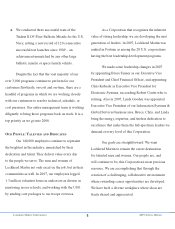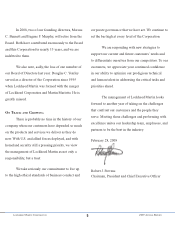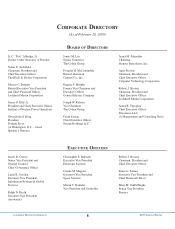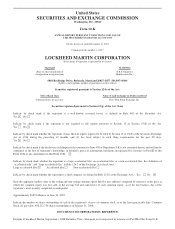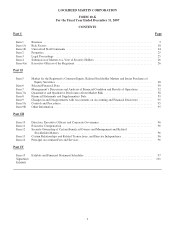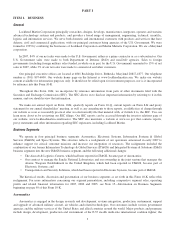Lockheed Martin 2007 Annual Report Download - page 16
Download and view the complete annual report
Please find page 16 of the 2007 Lockheed Martin annual report below. You can navigate through the pages in the report by either clicking on the pages listed below, or by using the keyword search tool below to find specific information within the annual report.In international sales, the purchasing government’s relationship with the U.S. and its industrial cooperation programs
are also important factors in determining the outcome of a competition. It is common for international customers to require
contractors to comply with their industrial cooperation regulations, sometimes referred to as offset requirements. As a result,
we have undertaken foreign offset agreements as part of securing some international business. For more information
concerning offset agreements, see “Contractual Commitments and Off-Balance Sheet Arrangements” in Management’s
Discussion and Analysis beginning on page 54 of this Form 10-K.
With respect to military aircraft, we compete with both domestic and international companies. Some or all of these
companies are competing, or preparing to compete, for unmanned military aircraft sales. Our military aircraft programs also
face potential competition from the application of commercial-aircraft derivatives to missions that require large aircraft and
the application of unmanned systems to various missions.
With respect to tactical fighters, the F-16 remains a formidable competitor especially on the basis of price and our
continued ability to update its capabilities with changes in sensor and weapons systems. The F-22 and F-35 are recognized as
the world’s only 5TH Generation fighter aircraft and are designed to be both lethal and survivable against emerging high-
threat systems. The F-22 is designed to provide air-dominance, strike and multi-mission stealth combat capabilities required
for conventional military operations. The U.S. Air Force is the only F-22 customer since international sales of the Raptor are
presently prohibited by the U.S. Congress. The F-35 is a cornerstone of future global defense cooperation and is planned to
replace several existing multi-role fighters for the U.S. and its allied partners. Due to the number of governments that have
agreed to participate in the SDD phase, we anticipate that significant international demand will develop for purchasing the
F-35.
Demand for air mobility aircraft is driven by the need to maintain or replace large numbers of aircraft for which
maintenance costs have been increasing and by the high development costs for new replacement aircraft. In some cases, the
choice has been to modernize and update the available aircraft. With some customers, new commercial aircraft derivatives
may make suitable replacement platforms and may be the final choice. In other cases, existing platforms may perform the job
more capably if modernized. In 2007, domestic and international customers opened numerous competitions for air mobility
aircraft or elected to procure new C-130J aircraft. The C-130J provides intra-theater airlift and a full range of tactical
mobility, refueling and humanitarian airlift capabilities.
In concert with changes in the way products are deployed, operated and supported, our customers are changing their
approach to sustainment of our platforms. Historically, nearly all domestic and international users of our fighter, transport
and special mission aircraft have sought to develop and maintain the capability to perform 100 percent of the necessary
support functions. Due to the combined factors of defense budget constraints, increased component reliability and decreased
(or eliminated) depot inspections, it is no longer cost effective for many customers to perform substantially all of their own
support functions. As a result, sustainment and logistics support opportunities have increased.
As the original equipment manufacturer for numerous platforms, we are focused on expanding our global sustainment
services, an increasingly important portion of the Aeronautics business. We continue to provide support through depot
partnerships and industrial cooperative relationships. Third-party providers offer competition within elements of the
sustainment portfolio. However, in the major areas of sustaining engineering, modification and upgrade, and supply chain
management, we, as the original equipment manufacturer, can spread development costs among multiple users and are in the
best position to affordably integrate production improvements into a customer’s existing complex systems.
Electronic Systems
Our Electronic Systems segment is engaged in the design, research, development, integration, production and
sustainment of high performance systems and subsystems for undersea, shipboard, land and airborne applications. Major
product lines include: tactical missiles and weapon fire control systems; air and sea-based missile defense systems; surface
ship and submarine combat systems; anti-submarine and undersea warfare systems; ground combat vehicle integration;
avionics, systems integration and program management for fixed and rotary-wing aircraft systems; radars; surveillance and
reconnaissance systems; and simulation and training systems.
8


